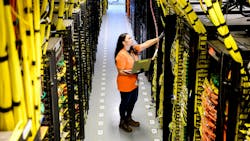Amazon Doubles Down on AI Infrastructure with $30B in New U.S. Data Center Investments
In another defining moment for the expansion of US hyperscale cloud infrastructure, Amazon Web Services (AWS) has announced over $30 billion in combined investments in Pennsylvania and North Carolina. It's another bold demonstration of development capacity which places AI innovation and workforce development at the center of the company’s next-generation data center strategy.
With $20 billion allocated to develop “AI innovation campuses” in Salem and Falls Townships, Pennsylvania, and another $10 billion to build out data center capacity in Richmond County, North Carolina, Amazon is sculpting a nationwide framework of cloud infrastructure to meet surging demand for generative and agentic AI at scale.
These two projects, among the largest private tech investments in the history of their respective states, underscore a broader national trend. To wit, hyperscale cloud platforms are racing to deploy AI-optimized compute infrastructure closer to power, land, and workforce opportunity, often in rural or emerging markets.
The Hyperscale AI Arms Race
Since the debut of ChatGPT in late 2022, capital expenditure by hyperscalers has grown at breakneck speed. In 2024 alone, global hyperscale capex surpassed $240 billion, according to Synergy Research Group -- a 44% year-over-year increase driven almost entirely by AI infrastructure needs. AWS, Microsoft, and Google now account for over half of that total.
AWS’s new campuses are designed to meet this moment. They will be powered by custom silicon (Trainium and Inferentia), designed for large language model (LLM) training and inference workloads, and embedded within AI-centric architectural designs.
“These investments are building the backbone for the next generation of generative and agentic AI,” said David Zapolsky, Amazon’s chief global affairs and legal officer. “We’re combining state-of-the-art infrastructure with long-term regional partnership models to build not just data centers, but economic engines.”
Pennsylvania: A $20 Billion Epicenter for AI
Amazon’s $20 billion investment in Pennsylvania marks one of the largest single-state cloud infrastructure deployments in U.S. history. The AI campuses in Salem and Falls Townships are projected to create 1,250 high-skilled jobs and support thousands more through construction and supply chain activity.
“This is the largest private sector investment in the history of Pennsylvania,” said Governor Josh Shapiro. “Amazon’s decision affirms that Pennsylvania is once again competing and winning on the national stage.”
The state is already working with AWS to identify additional sites, aiming to establish a broader regional AI corridor fueled by robust utility infrastructure, education pipelines, and public-private coordination.
Notably, Amazon’s Greencastle reverse logistics facility will play a role in sustaining these campuses by reconditioning server and networking gear, supporting circular economy principles amid global hardware demand.
Amazon is also pursuing clean energy commitments in Pennsylvania, with 12 solar farms under development and onsite solar projects planned for new data centers.
North Carolina: Building AI’s Southeast Backbone
Amazon’s $10 billion expansion in North Carolina centers on Richmond County, where AWS will create at least 500 high-skilled jobs and anchor a major Southeast AI and cloud innovation hub. The company’s total investment in the state now exceeds $22 billion since 2010.
“Artificial intelligence is changing the way we work and innovate,” said Governor Josh Stein. “This historic commitment affirms North Carolina’s place at the forefront of high-tech infrastructure.”
North Carolina’s appeal lies in its blend of available land, power infrastructure, and a fast-evolving fiber network, all crucial factors for AI-era data center siting.
Investing in Workforce, As Well as Workloads
In both states, Amazon is extending its hyperscale infrastructure playbook to include robust workforce development programs, seen increasingly as essential for securing long-term operational success and social license.
Through the AWS Information Infrastructure Pre-Apprenticeship (I2PA), Amazon will pay students and job seekers to train for roles in cloud infrastructure, ranging from data center technician to fiber optic splicer. Additional programs include:
- Fusion Splicing Certificate Courses, taught through community colleges and tech schools.
- Information Infrastructure Workshops for Educators, to align regional curricula with infrastructure careers.
- STEM engagement programs for K-12 schools, including We Build It Better, We Will Build It Better, and Think Big Experiences.
- Amazon Future Engineer Scholarships, supporting underrepresented students pursuing tech degrees and AWS internships.
In North Carolina, eight high school students have already received $40,000 scholarships under this program. In Pennsylvania, the Amazon Northeastern Pennsylvania Community Fund and the Amazon Richmond County Community Fund will distribute $400,000 in combined grants to support community-led projects around education, sustainability, and digital inclusion.
Building the Next Phase of Hyperscale In the Heartland
Amazon’s dual-pronged investment reflects a new phase in the evolution of hyperscale infrastructure: one where cloud giants not only race to meet compute demand but embed themselves in the regional economies, workforce ecosystems, and civic fabrics of their host communities.
AWS is making headlines in Pennsylvania and North Carolina that are becoming commonplace among hyperscalers. Microsoft, Google, and Meta have all stepped up their AI-focused infrastructure efforts in less traditional markets, driven by the same pressures: land, power, talent, and the need to keep pace with generative AI’s hunger for compute.
What’s emerging is a new pattern of hyperscale development. These data centers exceed their original job description to effectively become regional platforms for cloud and AI growth, designed to plug directly into local economies and education systems.
With a fresh $30 billion now committed across Pennsylvania and North Carolina, Amazon is sketching out a blueprint others are already following. The physical footprint is only part of the story. What’s growing alongside the racks and cooling systems is a long-term industry investment in people, training, and future-proof jobs.
The race to build AI infrastructure is accelerating, but so is the effort to root that infrastructure in communities that can sustain it. If the last era of cloud was about scale, this one may be about staying power.
At Data Center Frontier, we talk the industry talk and walk the industry walk. In that spirit, DCF Staff members may occasionally use AI tools to assist with content. Elements of this article were created with help from OpenAI's GPT4.
Keep pace with the fast-moving world of data centers and cloud computing by connecting with Data Center Frontier on LinkedIn, following us on X/Twitter and Facebook, as well as on BlueSky, and signing up for our weekly newsletters using the form below.
About the Author
Matt Vincent
A B2B technology journalist and editor with more than two decades of experience, Matt Vincent is Editor in Chief of Data Center Frontier.



